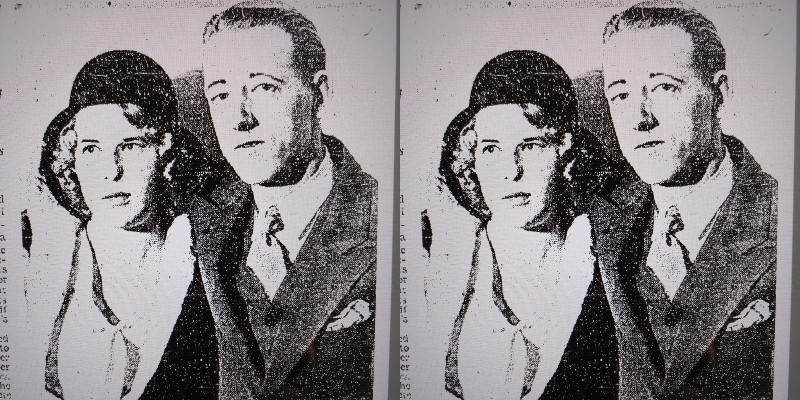It has been nearly 90 years since Bonnie Parker and Clyde Barrow were ambushed by police on a Louisiana backwoods road, and cut to pieces by gunfire.
The pair have entered the cultural lexicon and remained there, the term “Bonnie and Clyde” has come to be stand for any dangerous enterprise that involves young lovers, and has inspired many movies, television shows, books, and documentaries.
But several years before their deadly escapades thrilled America, two other young, star-crossed lovers named Lucille Walker and Alexander Mackay captured countless headlines as they led a six-week rampage of robberies across Los Angeles.
Starting just before Thanksgiving 1930, they committed several dozen hold-ups at drug stores and hotels, and the city’s newspapers reveled in the story of a seemingly-innocent young woman who had been drawn into a life of crime.
However, when she was first captured in January 1931, 19-year-old Walker was christened the “Red-Haired Bandit Queen” by the Los Angeles Times, and brazenly admitted that she planned and took part in nearly all the robberies – though the truth was somewhat different.
The Oklahoma-born “Queen of Crooks” called her arrest, for trying to buy a pistol with the 23-year-old Mackay, a “tough break,” and that only her first robbery was “exciting.” However, she denied using a gun during any of the crimes: instead, she said she pointed her finger in her pocket, making it look like a weapon, and insisted that no-one was ever hurt.
Also, despite her exotic nickname, Lucille was actually a blonde. She had dyed her eyebrows and lashes black and wore a red wig for a while, changing it to a brunette one when the police got on her tail. She smiled happily as she demonstrated how she switched wigs for the photographers.
She further explained that she used to work the soda fountain at a drug store, and it was here that she “got a line” by studying the cash till, and how the store distributed and handled money. Then, in debt and out of work, she met MacKay at a dance hall.
In a moment straight out of a movie, he asked her if she “had any nerve,” and she replied that yes, she did. Their criminal career was off and running – at least for a while.
Later in March, Otis Saunders, 21, was found to have three guns in his car when he was stopped by police in San Jose, and it emerged that while he, Lucille and Mackay had indeed previously robbed the Gaylord Hotel on Wilshire Boulevard (among others), it was Saunders and two other young men who had attacked the Gotham Hotel in downtown L.A.
Lucille and Mackay had been arrested on the gun charge after the Gotham robbery as part of a round-up of “usual suspects,” but since several people at the Gotham had been injured by gunfire (unlike the other robberies, when no one was), the criminal charges were likely to be more serious.
Potentially facing serious jail time, Lucille – who had also called herself Lucille Gordon – began to change her tune, and distance herself from being Mackay’s “sweetheart.”
Saunders was the real mastermind behind the dozens of robberies she insisted, and in fact MacKay had threatened Lucille and her mother, saying that they would both be “taken for a ride” if she didn’t join up and play bandit. In what seemed to be a romantic jailhouse gesture, MacKay nobly confirmed these allegations too, and swore that Lucille was completely innocent.
Lucille further insisted that she hadn’t got rich from her banditry anyway; she just got “room and board, a dress, hat, silk stocking and a $12 pair of shoes.” She also made an appeal to any soft-hearted newspaper readers – and future jurors – by saying that she sent the first $2,000 to her mother, and reasoned that she was just trying to “make a fair living.”
Even so, the jury took barely 20 minutes to find her guilty of involvement in three robberies, and Judge Walton J. Wood chastised MacKay and the lawyers for trying to exonerating Lucille. It was “utterly silly” and “an insult to the intelligence,” he thundered.
Both were sentenced to five years to life in the notorious San Quentin State Prison, though Lucille was transferred to Tehachapi Prison in southern California in in November 1933, and was allowed to apply for probation.
Perhaps her looks and charm had woven a spell behind bars, because it was extremely rare for someone convicted of such crimes to get such a concession. Sure enough, it proved to be a hasty decision by the authorities, as a note on her prison record indicated that after her release she went back to her wicked ways, and was wanted for robbery in Los Angeles in February 1935.
She never saw Alex Mackay again: just a few weeks before she was freed from Tehachapi, he was part of a four-man team that tried to escape from San Quentin by taking warden James Holohan, two guards, and several other State Board members hostage, and going on the run in Holohan’s car.
Chased by prison guards and state highway police, they – like Bonnie and Clyde – were trapped in an ambush, where a posse opened fire on them. One of the escapees was killed, while Mackay and the others surrendered. MacKay turned down a plea deal of kidnapping with violence, saying that “of the two deaths: the noose or slow death in prison, I’d rather have the fast one.”
He was indeed sentenced to hang, but then appeared to change his mind – and an unexpected international element came into play.
Mackay, who was born in Glasgow, Scotland, and therefore a British citizen, wrote to the Houses of Parliament in London, and, allegedly, even got his lawyer to appeal to England’s new King Edward VIII for clemency – but with no luck.
A late plea via the Canadian Prime Minister from Mackay’s mother, who lived in Montreal, didn’t stop the route to the gallows either, and despite several pleas and stays, both Mackay and one of his fellow escapees were executed on May 22, 1936.
Lucille’s reaction to her one-time lover’s death is unknown, and there were no other references to the 1935 robbery in police records – but by then another more shocking spree by two other young, gun-toting lovers and their gang had been seared into the American consciousness, and it surely helped her disappear into history.
As for Bonnie and Clyde, their Ford Deluxe V-8, riddled with over 100 bullet holes, is still on display in a Las Vegas casino.

















